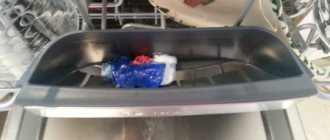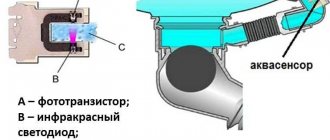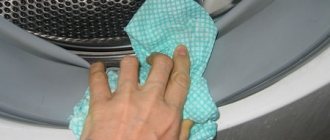With the purchase of a dishwasher, any housewife will sigh - finally, you can devote precious time to loved ones, friends and favorite hobbies. Few people think about cleaning and regular maintenance of equipment. After all, the device washes the dishes itself, which means it is clean. This is fundamentally wrong: if you do not take care of your dishwasher, the life of the appliance will be shortened and it will fail. Caring for your dishwasher will not cause much trouble, and the result will be excellent operation of the machine, without failures or surprises.
Daily preventive care
You need to keep your dishwasher clean regularly. We will describe the main procedures below.
- Once a week, wipe the door and panels of the device with a soft cloth soaked in soapy water.
- Wipe the interior surface dry after washing.
- The control panel is wiped with a semi-dry sponge, having previously wrung it out well.
- Once a month, run a washing cycle with a citric acid solution - this will prevent the formation of plaque and remove stains.
- After the wash cycle, leave the door slightly open to allow moisture to evaporate.
- Wipe the rubber seals first with a sponge and then with a dry cloth.
- Rinse the mesh filter once a week with clean water.
Operating instructions for Bosch dishwashers
The first start after purchasing a dishwasher is a strategically important moment! Never neglect this step, otherwise you can significantly reduce the life of the machine. The first use should be idle, that is, without dishes and detergents at maximum temperature. This is necessary in order to check the correct installation, the presence of leaks, extraneous sounds during operation, and also to wash off factory lubricants and dust.
The manufacturer often includes test strips in the package to determine water hardness. It is necessary to measure the water before starting and, based on this, add softening salt to a special compartment. This salt is necessary for the normal functioning of the machine and should always be available. Otherwise, if you do not use it, unsightly whitish stains will remain on the dishes, and scale can damage the heating elements.
The dishwasher adds salt when washing itself; you just need to constantly monitor its level. At the first start, water is added to the salt compartment; this will not be required in the future.
To effectively clean dishes, you need to load the machine correctly.
Simple rules will help you achieve ideal cleanliness of dishes and increase the service life of your Bosch dishwasher:
- Avoid overfilling and preventing the circulation of water and detergents.
- Start loading the machine from the bottom up. First, plates and dishes are set up.
- Mugs and bowls are placed on the top level. Glasses, glasses and other fragile dishes are secured with folding holders.
- Spoons, forks, and spatulas are placed vertically with the handle down. The knives are opposite, point down.
- Pots, pans and stewpans are placed on the lower level, having previously been rinsed to remove large food debris, as pieces of food can clog the filter. It is also better to soak dishes with burnt food in advance to get the best results.
For dishwashers, you will need a small arsenal of special chemicals. Liquids, powders and tablets are used as detergents. They are responsible for dissolving fat and removing dirt from dishes. For shine and quick drying of dishes, conditioner is added. For dosage, follow the manufacturer's recommendations on the packaging. Otherwise, the dishes may become sticky or streaky.
There are complex additives with conditioner, detergent and softening salt. But their inconvenience lies in the impossibility of choosing the right dosage of a particular product depending on the type of dishes and water hardness.
A dishwasher is bought in order to make the housewife’s work easier and ensure reasonable water savings. In order not to prepare yourself for unpleasant surprises from the very beginning, the installation and connection of this household appliance should be entrusted to specialists.
So, the machine is placed in the designated place, and the water supply and drain are connected. Now you can start using it.
Bosch, like a number of other manufacturers of household appliances, strongly recommends a test run of the dishwasher.
It is necessary to make a “idle” start for the following reasons:
- lubricants accidentally preserved on parts of the product, as well as dust and debris that got inside should be eliminated;
- we get the opportunity to check how well the machine is installed, evaluate the rate of water flow, its heating level, see how the entire work process proceeds, including the draining and drying stages;
- When problems are identified, it becomes possible to eliminate them at the test washing stage, eliminating the labor-intensive unloading of dishes.
We know that during regular washing you cannot do without special products, but a test run in this sense is no exception. You will need the regenerating salt and other detergents included in the starter kit that customers are usually asked to purchase with their dishwasher.
A test run of the dishwasher is necessary, first of all, to check the quality of its installation and make sure that the unit is in good working order.
What we need to know about the operating conditions of the purchased equipment is the level of water hardness in the region where it will operate. You are in luck with Bosch machines: buyers of this company’s products do not need to be guided by their own experience when determining hardness, or resort to traditional methods.
A number of models of this brand include test strips for determining hardness. You just need to lower the paper strip with the reagents applied to its surface into the water for just a couple of seconds.
And then compare it with the table provided by the manufacturer. After completing these simple steps, you will be ready to test run your purchase.
Proper connection of the dishwasher involves installing it in a specific place (1) and connecting it to the electrical network (2), water supply (3) and sewerage (4) using standard hoses and a power cord
The startup procedure is quite simple, you need to follow these steps sequentially:
- open the car by pulling the door towards you;
- pull out the lower basket to gain access to the lid covering the water softening salt reservoir;
- unscrew the lid, pour water into the reservoir and pour special salt from the starter kit into it;
- screw on the tank lid and remove any water that may have spilled into the chamber while loading salt with a rag;
- Now set the salt consumption on the control panel, taking into account the previously determined water hardness.
Let's add some clarification. Please note that water is poured into the salt tank only once - before the first start. It should be filled to the top.
The salt is poured in using a special funnel (or watering can), which is usually included in the kit. If you don't have a watering can, use a regular cup. Add salt until it becomes visible through the filler hole.
Water is poured into this hole, located at the bottom of the unit’s chamber, and special salt intended for dishwashers is added.
The water displaced during the backfilling process should not confuse you: this is how it should be. Once the reservoir lid is closed, the displaced water should be thoroughly wiped away. It should not be inside the camera.
We suggest you familiarize yourself with Dishwasher Care: how to clean and rinse the drain system at home
It remains to check whether the water supply tap is open, after which you can activate the first start. To visualize the entire algorithm of actions, watch the video that we posted at the bottom of this article.
Dishwashing detergents
To ensure that the machine works properly, special detergents designed specifically for dishwashers are used. These include:
- Dishwasher tablets. Each capsule contains dishwashing detergent, shine and rinse aid.
- Dishwasher powder. Using the instructions for your specific model, measure the volume for one wash cycle.
- Of the useful components, manufacturers add regeneration salt in the form of large grains to soften hard water. The chemical composition is the same as that of the table mineral, but it is cleared of solid particles that do not dissolve. It is placed in a special pull-out tray or hole designed for filling with salt.
- Dishwashing gel. It comes in the form of a capsule, which is designed for one cycle of operation of the device.
- Rinse aid. It is loaded into a special compartment intended for the final stage of washing.
- Air freshener that is attached to the top basket. It removes unpleasant odors, imparting aroma to the dishes.
Use of professional detergents
To wash dishes in the dishwasher, be sure to use special household chemicals, which include:
- detergents (tablets, gels, powders, capsules) necessary for better dissolution of fats and high-quality washing of dishes. Tablet detergent from the Korting range ensures correct operation of the device and copes with most stubborn dirt;
- salt, which is needed to prevent the appearance of scale inside the device (including on heating elements) and to soften hard water;
- rinse aid (to neutralize detergent and speed up the drying process);
- a comprehensive cleaning product (for example, the Korting range includes a complete dishwasher care kit, including cleaning tablets and a scale/grease remover).
If you follow simple care instructions, your dishwasher will operate smoothly and last for many years.
Deep cleaning
For preventative purposes, you should thoroughly clean your dishwasher every six months. You can carry out this procedure more often, especially if you use the device intensively and notice a decrease in its efficiency (the dishes are not cleaned perfectly). Such servicing of the dishwasher will return the original quality of the work performed. Below are algorithms for cleaning various parts of the device.
Filters:
- unload the machine from the cutlery nets;
- unscrew the protective covers that are secured with screws;
- take a toothbrush or a special brush for cleaning filters, gel for cleaning equipment;
- carefully clean the part;
- rinse the device with running water;
- reinsert the filter device.
Drain hole:
- We wash the holes near the drain with a sponge and soapy water;
- Use a toothpick to clean the injector holes, using a sponge to remove dirt and limescale deposits.
Holes in the blades of the washing shower:
- remove the clamp and remove the blades;
- if the holes are clogged with food debris or limestone deposits, clean them with a toothpick;
- rinse with running water;
- set back;
- if the blades rotate with difficulty, clean its axis.
Door seal:
- Wash the part with refrigerator cleaner or a proprietary cleaner;
- rinse with clean water.
Cleaning the internal and external surfaces:
- spray the walls of the case with glass cleaner, then wipe with a dry cloth;
- Wipe baskets with dishwashing detergent;
- Wipe the handle and control panel with a soft cloth;
- Clean the detergent compartments with a toothbrush and rinse with running water;
- Wash the inside of the unit and the rubber seals with soapy water.
Dishwasher Care
In order for a “home assistant” to serve as long as possible, she needs to be looked after regularly. Otherwise, filters and pipes become clogged. Filler and drain hoses are often damaged, resulting in a leak.
Some activities need to be done daily. Servicing a Bosch dishwasher (and other brands) includes cleaning:
- filters;
- sprinklers;
- internal walls;
- tray for powders or tablets.
It is important to regularly care for your dishwasher, inspect and clean the hoses. To protect the machine from scale, use special salt. It is poured into a compartment at the bottom of the chamber. Every 3-4 weeks you need to add the required amount. A special light indicator on the machine panel reminds you of this.
Recommendations from dishwasher manufacturers
Household appliances from different manufacturers may have differences in operation and care. Recommendations are given in the instructions for use.
Bosch recommends the use of branded cleaning agents. The machine is treated monthly with a liquid to remove grease, and once every six months - with a special composition for intensive cleaning.
Manufacturers of the Siemens, Beko, Hotpoint Ariston, Indesit, and Hansa brands recommend using Calgonit Fusion Power for cleaning.
In addition, it is important to install the equipment correctly. All manufacturers advise placing the machine on a perfectly flat surface. Built-in models must be securely fixed.
Daily care
After each cycle, the machine is turned off and the door is opened. You should be careful not to burn yourself on hot dishes after drying.
When the inner chamber is freed, you need to remove the filters from the bottom of the mesh. It is important to rinse them thoroughly to remove any remaining food, then rinse under running water. After this, the filters are returned to their place. The inner walls are wiped with a dry cloth. If solid particles are stuck in the cracks, they must be removed.
Opening the door
On most models, the door automatically locks at the beginning of the cycle. Some appliances have an “add dirty plate” option – the ability to open the machine and add dishes. The device will automatically stop working, and then continue working when the camera is closed. If there is hot water in the chamber, there is a risk of burning your hands: you need to be careful.
At the end of the wash, the door will unlock and open slightly to improve drying quality. This feature can be disabled if desired. When drying is complete, the machine beeps or the indicator light comes on.
Having freed the chamber from the dishes, the door is left open so that the device dries thoroughly from the inside. This prevents the proliferation of microbes in the chamber and the appearance of mold.
Seal care
Every day after washing the dishes, check the condition of the rubber seals on the doors. They ensure tightness and safe operation. During washing, the seals are not washed with water, so they need to be looked after separately:
- remove food debris from crevices using toothpicks or rags;
- wipe away traces of grease and dirt with a damp cloth and a mild detergent;
- Wipe the cleaned rubber bands dry with a clean napkin.
Accumulation of fat and contamination of seals lead to loss of tightness. As a result, the machine may fail.
Body care
It is equally important to keep the outer walls of the kitchen appliance clean. Often they appear stained with grease, splashes and other contaminants.
You can clean the outside of the walls with a soft, damp cloth. Heavy soiling can be removed with detergent. You can spray a special spray for cleaning refrigerators and wait a few minutes. The active substances will dissolve grease and dirt, then the machine can be easily cleaned with a damp cloth.
It is not recommended to use for care:
- hard sponges, metal mesh;
- sharp objects;
- abrasive powders.
The stainless steel body (Hansa and Electrolux machines) cannot be washed with chlorine-containing bleaches. If scratches appear on the surface, you can use polishing compounds for household appliances.
Anti-scale
Limestone deposits are caused by hard water. To prevent this, replenish the salt reservoir or add water softener. If a white coating has already formed, you will need one of the components to clean it:
- lemon acid;
- bicarbonate of soda;
- baking soda;
- table vinegar.
Place the selected substance in the dishwasher. The optimal temperature is 600. Afterwards, remove dirt and stains with a damp cloth. Run another cycle with just water.
You can prepare a product based on baking soda (400 g) and hydrogen peroxide (3 tbsp). Add 20 drops of essential oil to the mixture. Mix the ingredients and form small balls. Place the mixture on the bottom shelf of the appliance, and on the top shelf - 400 ml of vinegar with the addition of a spoonful of detergent. Then turn on the washing cycle, after which remove the remaining product with a damp cloth.
You should not use the product too often - after all, it is a chemical compound.
Fighting mold and rust
If mold and scale forms, you must perform the following actions:
- Using a product with a bleaching effect (1 glass per 2 liters of water), clean the inside of the device;
- remove scale with a sponge and solution, diluting half a glass of ammonia with 4 liters of water;
- At the end of the procedure, start the rinse mode.
Since bleaches have a strong chemical effect, do not overuse them. If the body is made of stainless steel, they cannot be used.
If rust has formed on the coating of a basket for metal objects, it is better to replace the component or coat it with a special sealant paint. If the reason is rusty pipes, the only solution is to replace them. When water with a high iron content comes into your taps, try installing filters to remove impurities from it.
Recommendations
Use only proprietary dishwasher detergents, not dishwashing liquid. The unit is not intended for washing cutlery and plates in a thick layer of foam. Do not overload the unit with dishes: place contaminated items so that the distribution arms rotate easily. When removing dishes, unload the lower basket first and then the upper one. Dry the rubber parts every few months.
Do not use utensils made of wood, plastic, porcelain, real glass, copper, tin, or stainless steel. Decorative glass items may break and damage the appliance, and it is recommended to wash grates and large baking trays using a nozzle. To do this, you need to remove the box and install the nozzle. Before loading dishes, remove any remaining food from them. Cutlery with residues of wax, tobacco ash, paint, or grease should also not be washed in the dishwasher.
To ensure that the device functions correctly and is stable, place the equipment under a pass-through countertop that connects to nearby cabinets.











